Numerical Study on Attitude and Resistance of a Side-Damaged Ship during Steady Flooding
Abstract
1. Introduction
2. Methods
3. Studied Cases and Validation
3.1. Ship and Compartment Models
3.2. Validation for Intact Ship
4. Attitude and Resistance of Damaged Ship
4.1. Symmetrical Flooding
4.2. Asymmetric Flooding
5. Conclusions
- For the side-damaged cases, the heel and trim of the ship at different forward speeds are similar to those in the zero-speed case. The main change of ship attitudes is that the sinkage gradually increases as the speed increases. The sinkage of the ship with forward speed is larger than that of the zero-speed ship. Compared with the symmetrical flooding case, due to the differences between the volume and distribution of water in the compartments, the sinkage of the ship under asymmetric flooding at different forward speeds decreases by an average of 42%, while the heel angle increases by about 15°.
- Compared with the intact ship, the resistance of the ship under symmetrical flooding increases from 27% to 42% at different forward speeds. Water flooding causes the ship to sink. The increase of the hull wet surface causes the increase of the ship resistance at different forward speeds, which ranges from 19% to 34%. In addition, the existence of opening disturbs the flow field around the ship and makes the ship resistance increase from 6% to 13%. The resistance of the ship under asymmetric flooding is slightly lower than that of the ship under symmetric flooding. Compared with the intact ship, the resistance of the ship under asymmetric flooding increases from 18% to 33%.
- Compared with the intact ship, the pressure resistance of the damaged ship at different forward speeds increases from 47% to 150%. The proportion of pressure resistance in the total resistance also increases from 17% to 89%. The main component of the increased resistance for the damaged ship is the pressure resistance.
- During the steady flooding, the water movement in the compartments behaves as vortex flow. The profile of the internal water surface remains constant for the same forward speed. With the speed increases, the vortex flow in the compartments becomes complex. The water surface fluctuates significantly. Consequently, the compartment resistance increases. The proportion of compartment resistance in the total resistance ranges from 9% to 20% at different forward speeds.
Author Contributions
Funding
Institutional Review Board Statement
Informed Consent Statement
Conflicts of Interest
References
- Marco, P.E.H.; Jeonghwa, S.; Hamid, S.H. Numerical simulations for the safe return to port of a damaged passenger ship in head or following seas. Ocean Eng. 2017, 143, 305–318. [Google Scholar]
- Zhang, X.L.; Mancini, M.; Lin, Z.; Li, P. Numerical investigation into the effect of damage openings on ship hydrodynamics by the overset mesh technique. J. Mar. Sci. Eng. 2020, 8, 11. [Google Scholar] [CrossRef]
- Acanfora, M.; Begovic, E.; Luca, F.D. A Fast simulation method for damaged ship dynamics. J. Mar. Sci. Eng. 2019, 7, 111. [Google Scholar] [CrossRef]
- Sadat-Hosseini, H.; Kim, D.H.; Carrica, P.M.; Rhee, S.H. URANS simulations for a flooded ship in calm and regular beam waves. Ocean. Eng. 2016, 120, 318–330. [Google Scholar] [CrossRef]
- Ermina, B.; Alexander, H.D.; Atilla, I.; Domenica, P. Roll damping assessment of intact and damaged ship by CFD and EFD methods. In Proceedings of the 12th International Conference on the Stability of Ships and Ocean Vehicles, Glasgow, UK, 13–19 June 2015. [Google Scholar]
- Song, S.; Ravenna, R.; Dai, S. Experimental investigation on the effect of heterogeneous hull roughness on ship resistance. Ocean Eng. 2021, 223, 108590. [Google Scholar] [CrossRef]
- Song, S.; Dai, S.; Demirel, Y.K. Experimental and theoretical study of the effect of hull roughness on ship resistance. J. Ship Res. 2021, 65, 62–71. [Google Scholar] [CrossRef]
- Niklas, K.; Pruszko, H. Full-scale CFD simulations for the determination of ship resistance as a rational, alternative method to towing tank experiments. Ocean Eng. 2019, 190, 106435. [Google Scholar] [CrossRef]
- Zhang, X.L.; Mancini, M.; Lin, Z.; Li, P. Numerical simulation of the ship resistance of KCS in different water depths for model-scale and full-scale. J. Mar. Sci. Eng. 2020, 8, 745. [Google Scholar]
- Linde, F.; Ouahsine, A.; Huybrechts, N.; Sergent, P. Three-Dimensional numerical simulation of ship resistance in restricted waterways: Effect of ship sinkage and channel restriction. J. Waterw. Port. Coastal. Ocean. Eng. 2017, 143, 06016003. [Google Scholar] [CrossRef]
- Ravenna, R.; Song, S.; Shi, W.C.; Sant, T. CFD analysis of the effect of heterogeneous hull roughness on ship resistance. Ocean Eng. 2022, 258, 111733. [Google Scholar] [CrossRef]
- Ali, M.A.; Peng, H.; Qiu, W. Resistance prediction of two fishing vessel models based on RANS solutions. Phys. Chem. Earth Parts A/B/C 2019, 113, 115–122. [Google Scholar] [CrossRef]
- Cucinotta, F.; Mancini, D.; Sfravara, F.; Tamburrino, F. The effect of longitudinal rails on an air cavity stepped planing hull. J. Mar. Sci. Eng. 2021, 9, 470. [Google Scholar] [CrossRef]
- Cucinotta, F.; Guglielmino, E.; Sfravara, F. A critical CAE analysis of the bottom shape of a multi stepped air cavity planing hull. Appl. Ocean Res. 2019, 82, 130–142. [Google Scholar] [CrossRef]
- Basic, J.; Degiuli, N.; Deihalla, R. Total resistance prediction of an intact and damaged tanker with flooded tanks in calm water. Ocean Eng. 2017, 130, 83–91. [Google Scholar] [CrossRef]
- Zhang, X.Y.; Sun, L.P.; Sun, C.; Wang, C. Study on the influence of the moonpool on the smooth water resistance performance of the ship. Ocean Eng. 2021, 237, 1–13. [Google Scholar] [CrossRef]
- Shi, X.; Chen, X.Q.; Tan, J.H. Study of resistance performance of vessels with notches by experimental and computational fluid dynamics calculation methods. J. Shanghai Jiaotong Univ. 2010, 15, 340–345. [Google Scholar] [CrossRef]
- Erik, H.; John, T. Effect of the Moonpool on the Total Resistance of a Drillship. Master’s Thesis, Chalmers University of Technology, Gothenburg, Sweden, 2012. [Google Scholar]
- Machado, L.; Fernandes, A.C.; Hussain, A.A. Effects on drillship resistance of a large moonpool using CFD simulations with experimental validation. In Proceedings of the ASME 2016 35th International Conference on Ocean, Offshore and Arctic Engineering, Busan, South Korea, 19 June 2016. [Google Scholar]
- Li, Y.Z.; Zhang, H.B. On flow field and additional resistance of moonpool in drillship with CFD. Ship Boat. 2015, 26, 10–15. [Google Scholar]
- Sivabalan, P. Influence of moonpool on the total resistance of a drillship by the effect of water motions inside the moonpool. Sustain. Mar. Struct. 2019, 1, 35–40. [Google Scholar]
- Ma, P.; Xing, X.; Yan, D. Drillship moonpool design to reduce added resistance for fuel saving. In Proceedings of the Offshore Technology Conference, Houston, TX, USA, 2–5 May 2016. [Google Scholar]
- Lee, S.K.; Xu, L. CFD Study and Model Test Verification of Moonpool Configuration Modifications for Minimizing Drillship Resistance. In Practical Design of Ships and Other Floating Structures, Proceedings of the 14th International Symposium, PRADS 2019, Yokohama, Japan, 22–26 September 2019; Springer: Singapore, 2019; pp. 3–27. [Google Scholar]
- Zhang, X.L.; Li, P.; Mancini, S. Numerical investigation into the resistance performance for the damaged DTMB 5415 ship in calm water and regular head waves. Ships Offshore Struct. 2021, 10, 1–12. [Google Scholar] [CrossRef]
- Zhang, X.L.; Lin, Z.; Li, P. A numerical investigation on the effect of symmetric and asymmetric flooding on the damage stability of a ship. J. Mar. Sci. Eng. 2020, 25, 1157–1165. [Google Scholar] [CrossRef]
- Gao, Z.; Wang, Y.; Su, Y. On damaged ship motion and capsizing in beam waves due to sudden water ingress using the RANS method. Appl. Ocean Res. 2020, 95, 102047. [Google Scholar] [CrossRef]
- Begovic, E.; Mortola, G.; Incecik, A.; Day, A.H. Experimental assessment of intact and damaged ship motions in head, beam and quartering seas. Ocean Eng. 2013, 72, 209–226. [Google Scholar] [CrossRef]
- Olivieri, A.; Pistani, F.; Avanzini, A.; Stern, F.; Penna, R. Towing Tank Experiments of Resistance, Sinkage and Trim, Boundary Layer, Wake, and Free Surface Flow around a Naval Combatant INSEAN 2340 Model; IIHR-TR-421; College of Engineering, The University of Iowa: Iowa City, IA, USA, 2001. [Google Scholar]
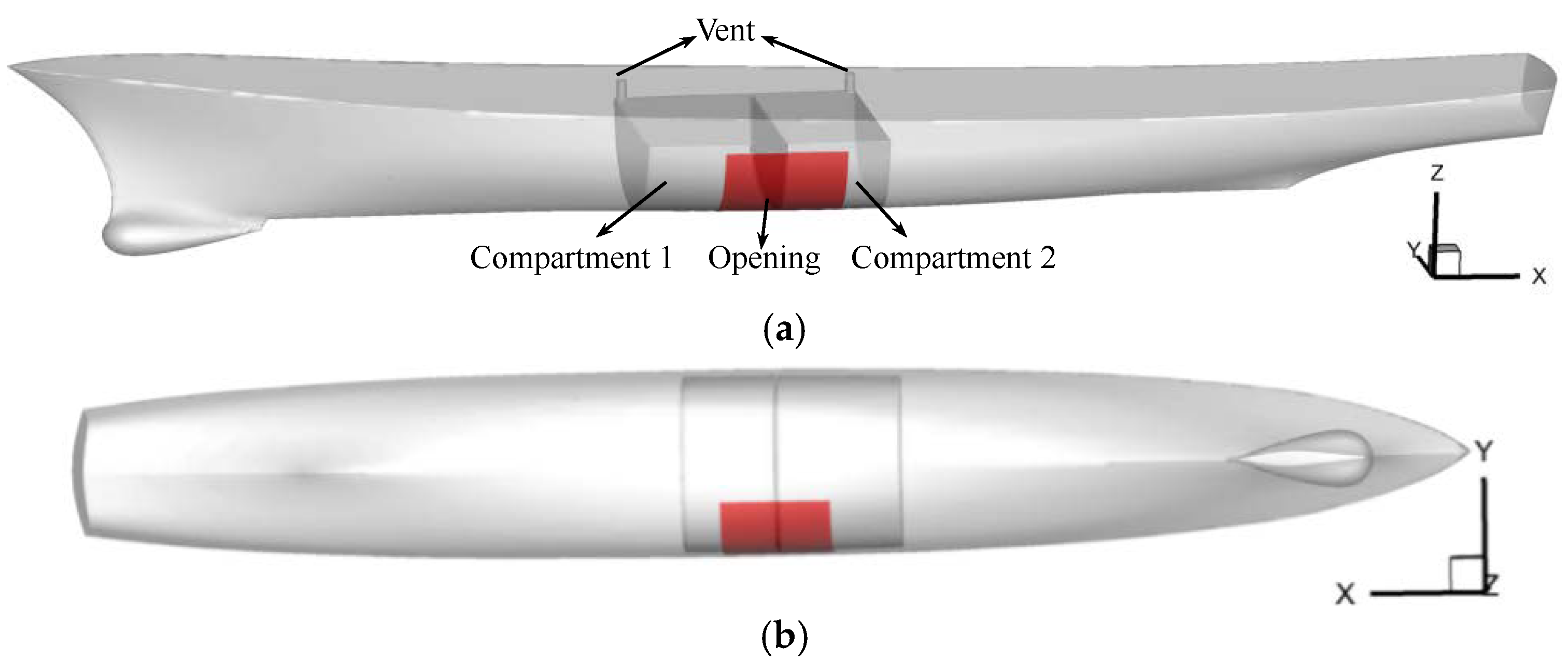
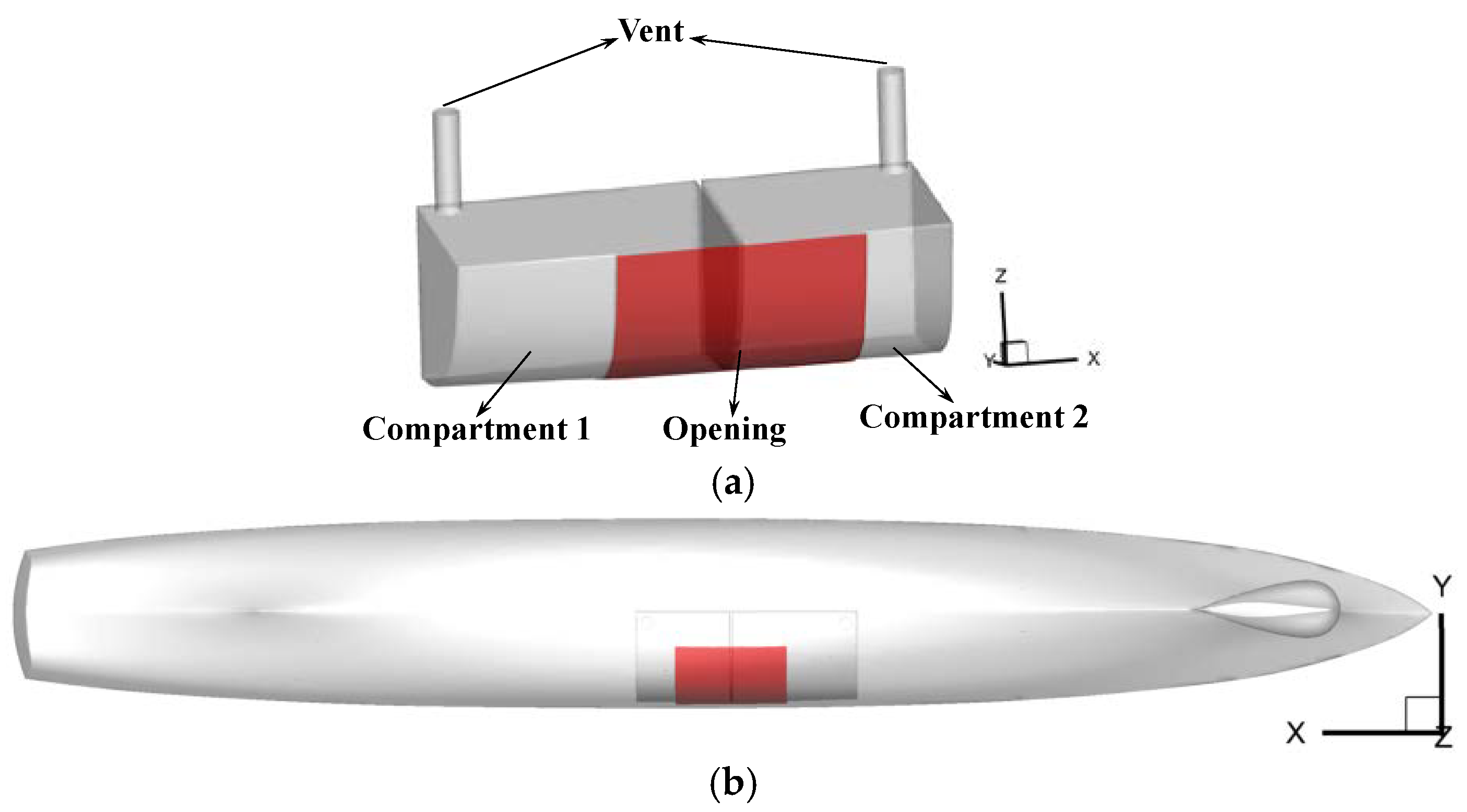


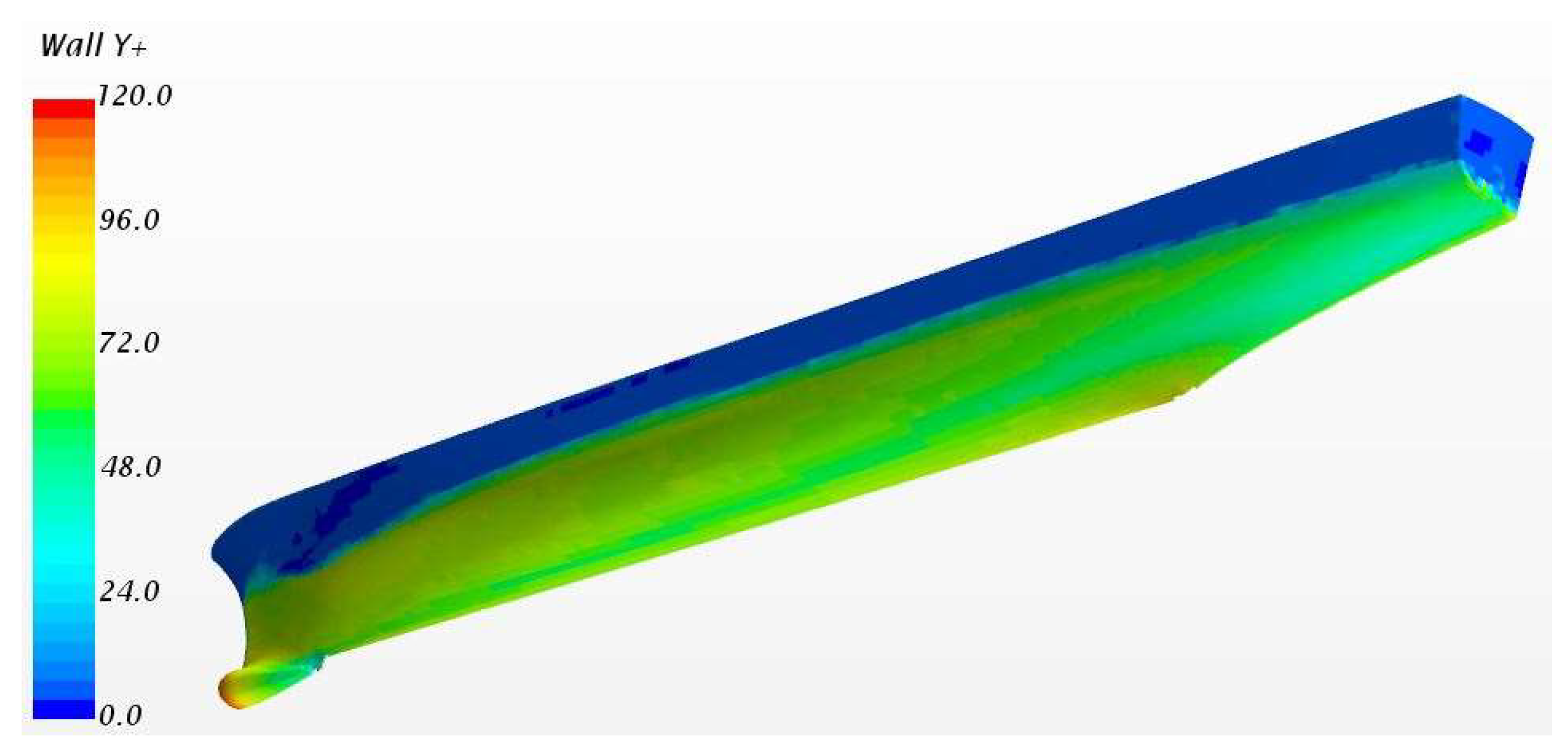
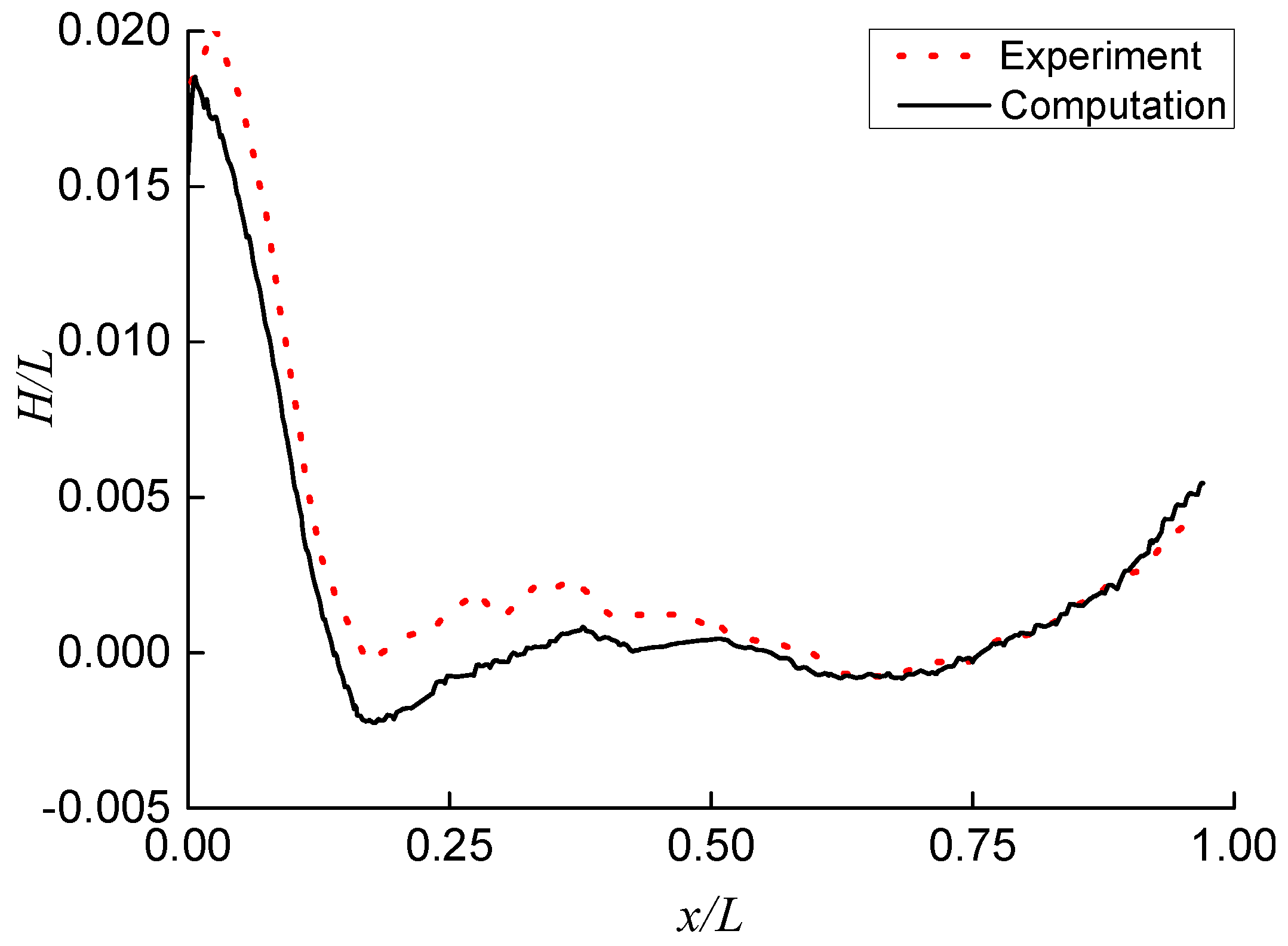
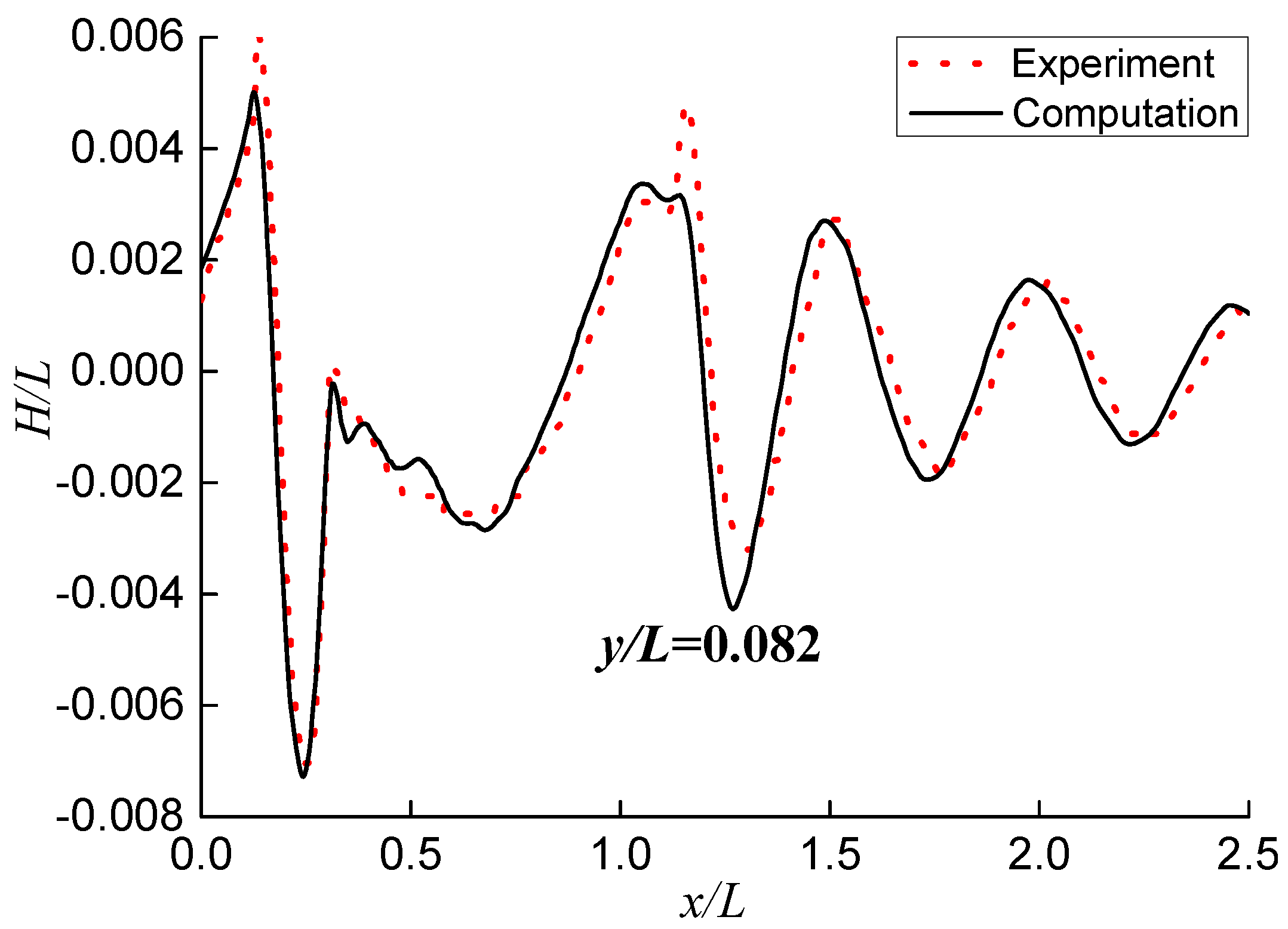

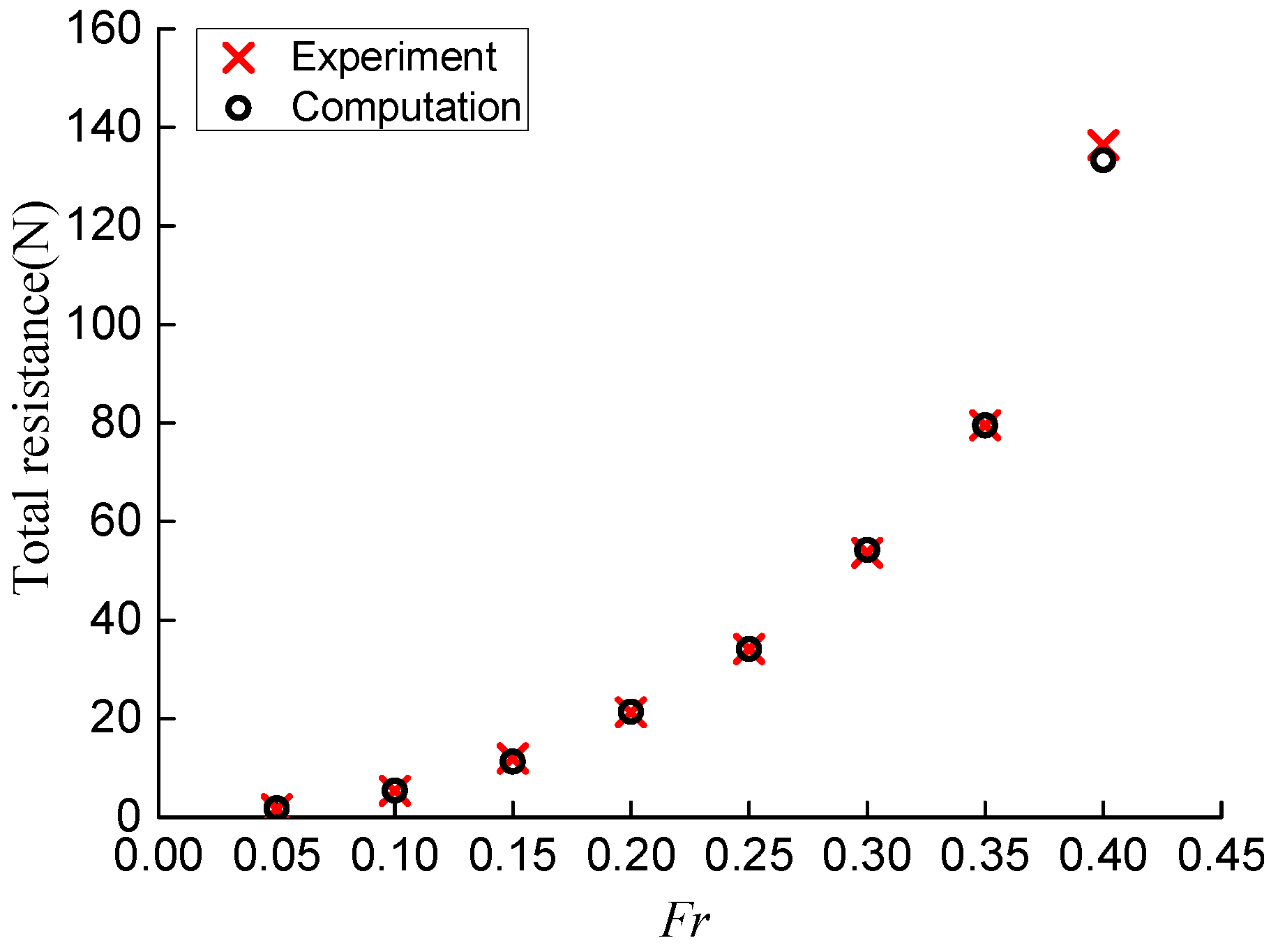
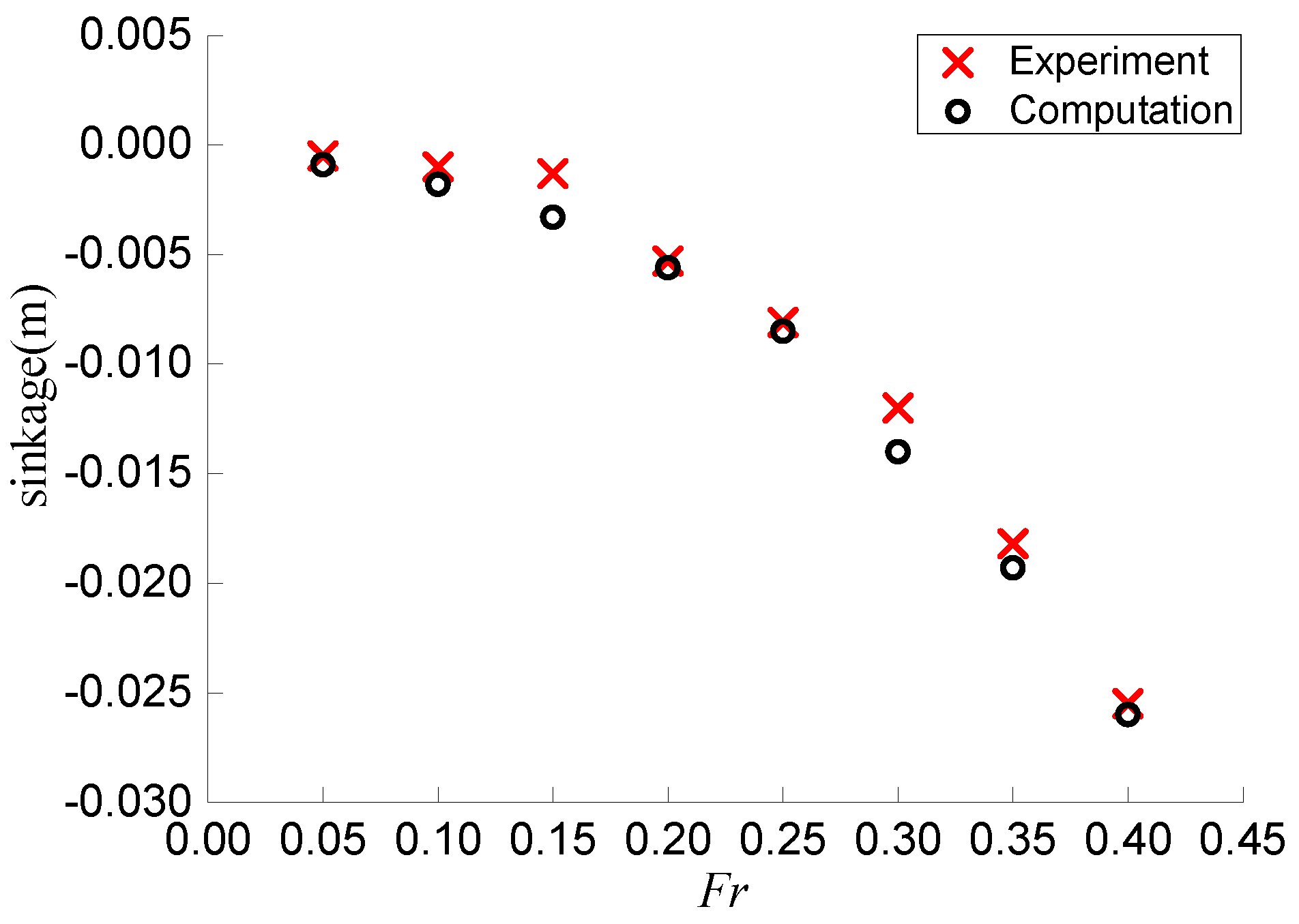

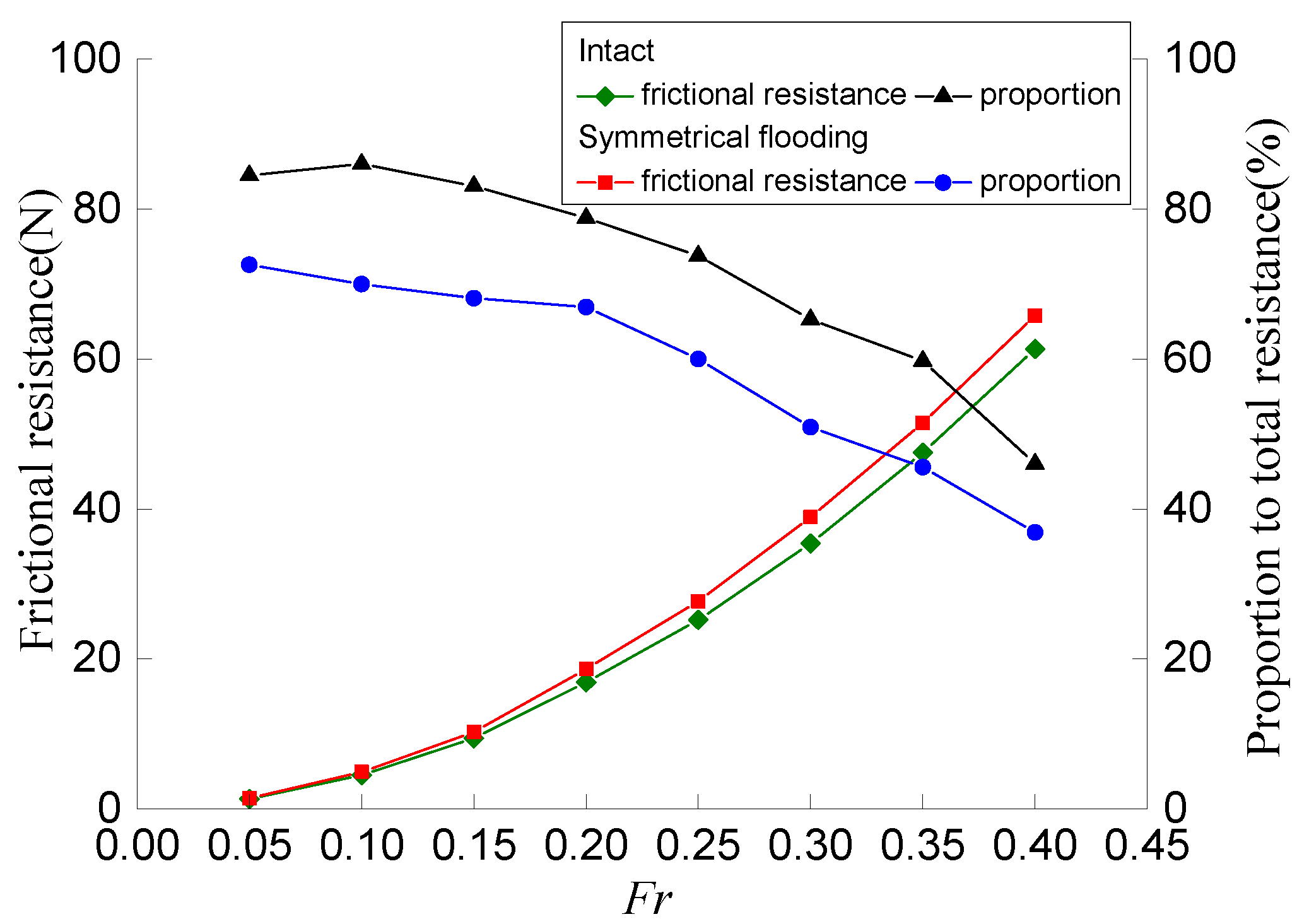
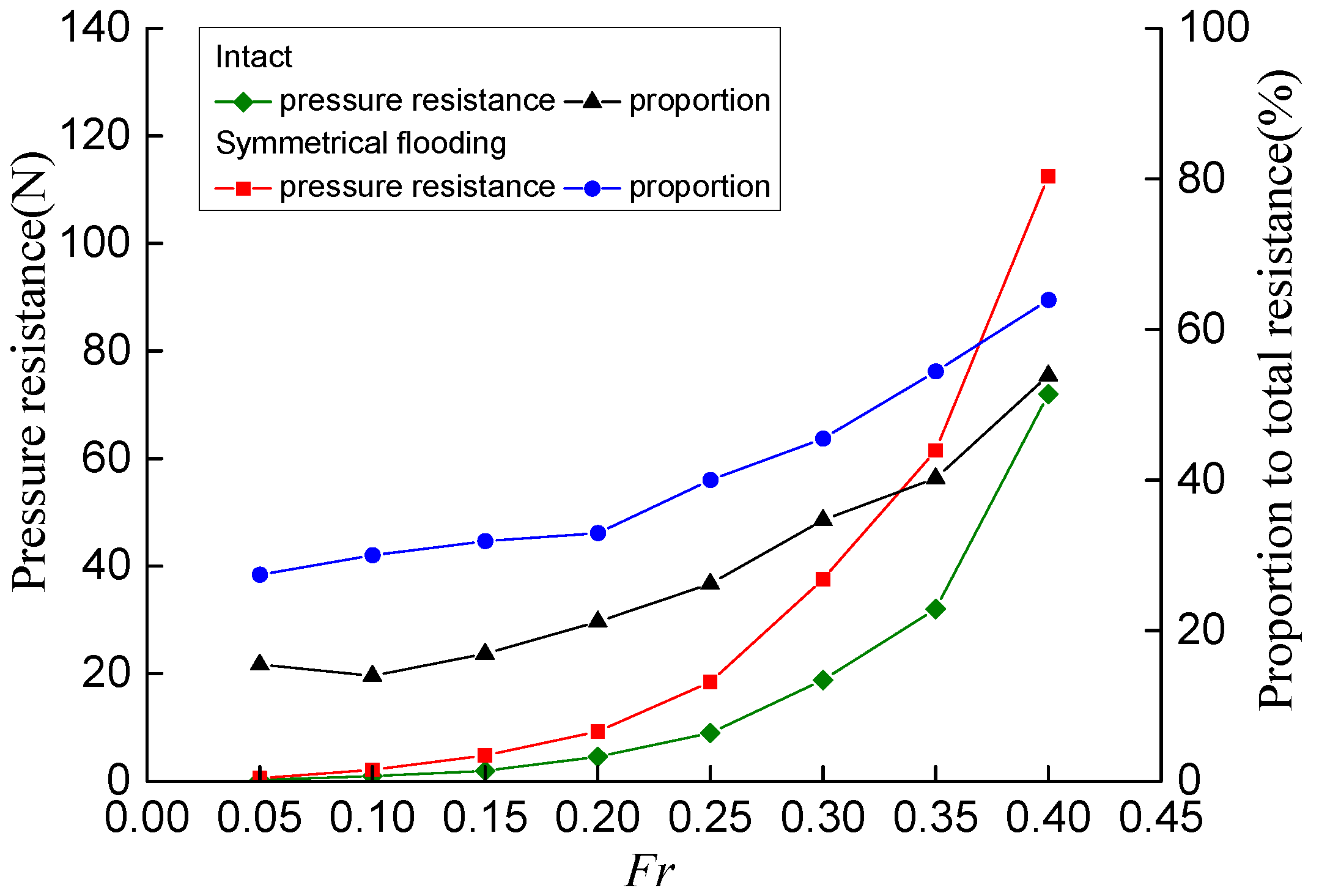
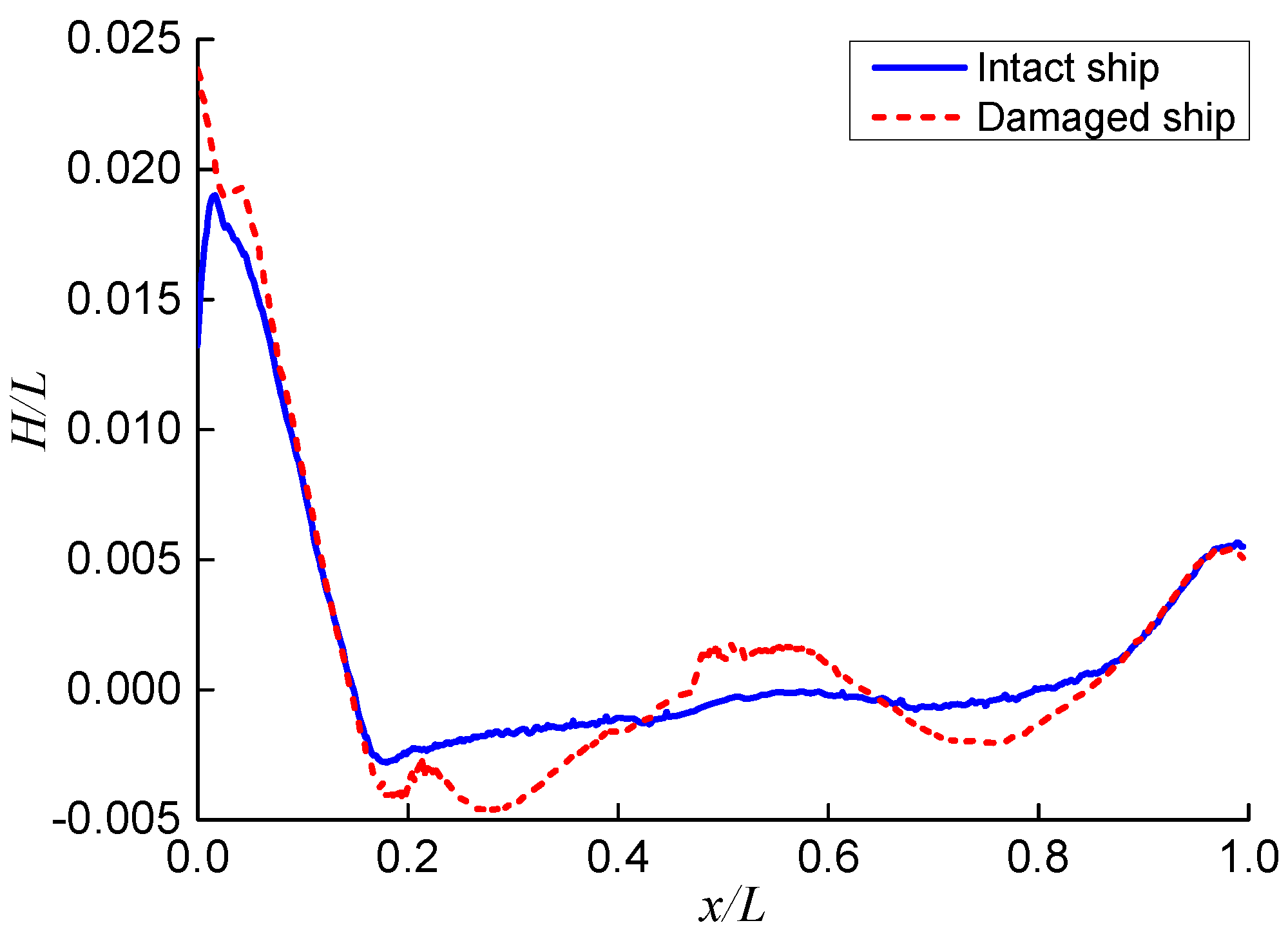
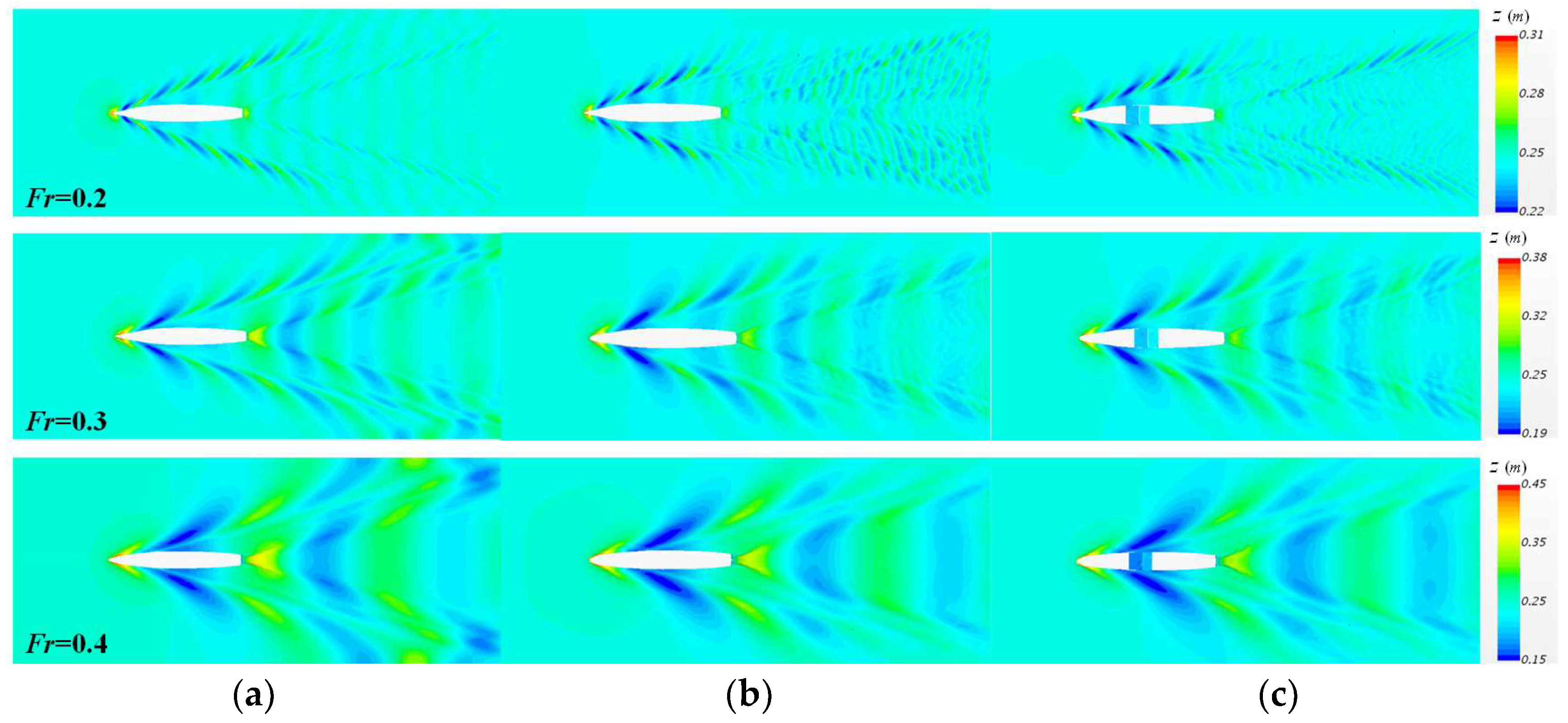
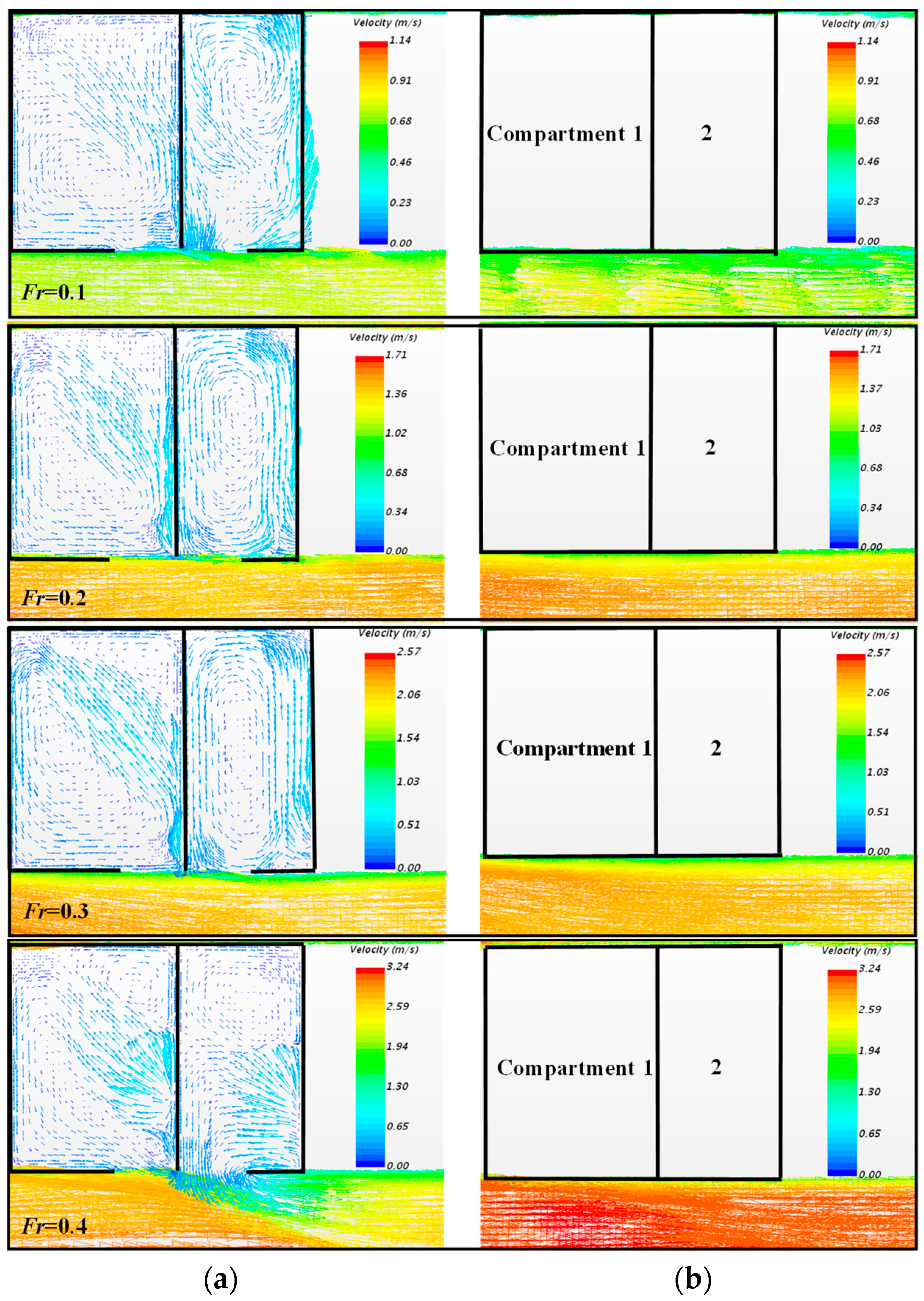
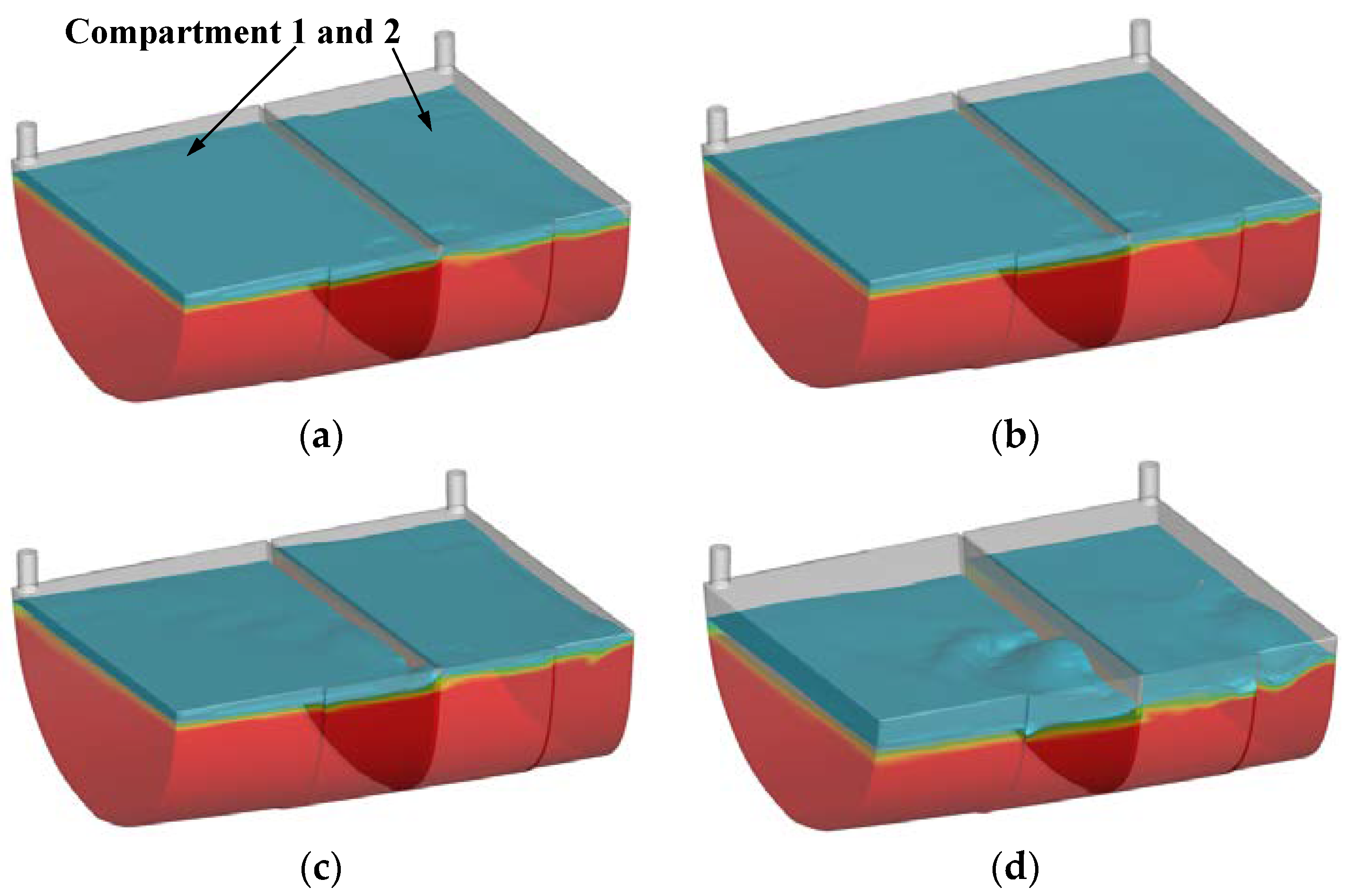


| Main Particulars | Full Scale | Model Scale (1/24.83) |
|---|---|---|
| Length of waterline (L) (m) | 142.0 | 5.719 |
| Breadth of waterline (B) (m) | 19.06 | 0.768 |
| Draft (T) (m) | 6.15 | 0.248 |
| Displacement (Δ) (ton) | 8636.0 | 0.554 |
| Vertical center of gravity from baseline (KG) (m) | 7.555 | 0.304 |
| Roll radius of gyration rxx (m) | 7.052 | 0.284 |
| Pitch radius of gyration ryy (m) | 35.5 | 1.429 |
| Main Properties | Full Scale | Model Scale (1/24.83) |
|---|---|---|
| Length of damaged opening (m) | 12.15 | 0.49 |
| Height of damaged opening (m) | 7.69 | 0.31 |
| Distance between front of compartment 1 and stern (m) | 65.66 | 2.645 |
| Distance between end of compartment 1 and stern (m) | 76.35 | 3.077 |
| Distance between end of compartment 2 and stern (m) | 90.02 | 3.626 |
| Volume of compartment 1 (m3) | 1510 | 0.099 |
| Volume of compartment 2 (m3) | 1189 | 0.078 |
| Mesh | Number of Mesh | Size of Mesh Near the Free Surface in Three Directions | Thickness of the First Cell Near the Hull Surface | Y+ on the Hull Wet Surface | ||
|---|---|---|---|---|---|---|
| x | y | z | ||||
| Fine | 6.52 million | 0.028 m | 0.028 m | 0.007 m | 0.0015 m | 40~120 |
| Medium | 3.48 million | 0.04 m | 0.04 m | 0.01 m | ||
| Coarse | 2.54 million | 0.057 m | 0.057 m | 0.014 m | ||
| Mesh | Total Resistance (N) | Sinkage (m) | Trim (°) | ||||||
|---|---|---|---|---|---|---|---|---|---|
| Num. | Exp. | Error (%) | Num. | Exp. | Error (%) | Num. | Exp. | Error (%) | |
| Fine | 44.61 | 44.50 | +0.2 | −0.0116 | −0.0104 | +11.5 | −0.457 | −0.108 | +323 |
| Medium | 44.77 | +0.6 | −0.0116 | +11.5 | −0.460 | +326 | |||
| Coarse | 44.98 | +1.1 | −0.0117 | +12.5 | −0.464 | +330 | |||
| Variable | RG | PG | δRE | CG | UG | UG (D%) |
|---|---|---|---|---|---|---|
| Resistance | 0.76 | 0.78 | 0.51 | 0.31 | 0.51 | 1.14 |
| Timesteps (s) | Total Resistance (N) | Sinkage (m) | Trim (°) | ||||||
|---|---|---|---|---|---|---|---|---|---|
| Num. | Exp. | Error (%) | Num. | Exp. | Error (%) | Num. | Exp. | Error (%) | |
| 0.0025 | 45.41 | 44.50 | +2.0 | −0.0114 | −0.0104 | +9.6 | −0.456 | −0.108 | +322 |
| 0.005 | 45.18 | +1.5 | −0.0115 | +10.6 | −0.457 | +323 | |||
| 0.01 | 44.77 | +0.6 | −0.0116 | +11.5 | −0.460 | +326 | |||
| Variable | RT | PT | δRE | CT | UT | UT (D%) |
|---|---|---|---|---|---|---|
| Resistance | 0.56 | 0.83 | −0.29 | 0.26 | 0.29 | 0.65 |
| Mesh Sizes (m) | Number of Mesh Inside the Compartment | Resistance (N) |
|---|---|---|
| 0.014 | 30,997 | 76.28 |
| 0.01 | 87,675 | 76.42 |
| 0.007 | 247,982 | 76.72 |
| Fr | Sinkage (m) | Trim (°) | Heel (°) | ||
|---|---|---|---|---|---|
| Intact | Symmetrical Flooding | Intact | Symmetrical Flooding | Symmetrical Flooding | |
| 0.00 | 0.0 | −0.052 | −0.31 | −0.71 | 0.60 |
| 0.05 | −0.001 | −0.056 | −0.32 | −1.06 | 0.59 |
| 0.10 | −0.002 | −0.057 | −0.33 | −1.07 | 0.59 |
| 0.15 | −0.003 | −0.058 | −0.36 | −1.10 | 0.59 |
| 0.20 | −0.006 | −0.061 | −0.39 | −1.15 | 0.58 |
| 0.25 | −0.008 | −0.064 | −0.43 | −1.18 | 0.58 |
| 0.30 | −0.014 | −0.070 | −0.44 | −1.21 | 0.58 |
| 0.35 | −0.019 | −0.071 | −0.45 | −1.19 | 0.62 |
| 0.40 | −0.026 | −0.073 | −0.14 | −0.82 | 0.39 |
| Fr | Intact | Damage-Repaired (Increased Ratio) | Symmetrical Flooding (Increased Ratio) |
|---|---|---|---|
| 0.05 | 1.55 | 1.85 (19%) | 1.97 (27%) |
| 0.10 | 5.43 | 6.50 (20%) | 7.03 (29%) |
| 0.15 | 11.34 | 13.56 (20%) | 15.03 (33%) |
| 0.20 | 21.44 | 25.49 (19%) | 27.90 (30%) |
| 0.25 | 34.16 | 43.09 (26%) | 46.16 (35%) |
| 0.30 | 54.24 | 72.49 (34%) | 76.42 (41%) |
| 0.35 | 79.52 | 105.42 (33%) | 112.98 (42%) |
| 0.40 | 133.32 | 171.03 (28%) | 178.32 (34%) |
| Fr | Compartment | Hull | ||
|---|---|---|---|---|
| Frictional Resistance (Proportion) | Pressure Resistance (Proportion) | Frictional Resistance (Proportion) | Pressure Resistance (Proportion) | |
| 0.05 | 0.001 (0.1%) | 0.17 (8.6%) | 1.43 (72.5%) | 0.37 (18.8%) |
| 0.10 | 0.01 (0.1%) | 0.71 (10.1%) | 4.90 (69.7%) | 1.41 (20.1%) |
| 0.15 | 0.01 (0.1%) | 1.68 (11.2%) | 10.21 (67.9%) | 3.13 (20.8%) |
| 0.20 | 0.02 (0.1%) | 3.03 (10.9%) | 18.65 (66.8%) | 6.20 (22.2%) |
| 0.25 | 0.05 (0.1%) | 7.71 (16.7%) | 27.65 (59.9%) | 10.75 (23.3%) |
| 0.30 | 0.08 (0.1%) | 9.01 (11.8%) | 38.83 (50.8%) | 28.50 (37.3%) |
| 0.35 | 0.22 (0.2%) | 11.84 (10.5%) | 51.27 (45.4%) | 49.65 (43.9%) |
| 0.40 | 0.25 (0.1%) | 14.95 (8.4%) | 65.54 (36.8%) | 97.58 (54.7%) |
| Fr | Sinkage (m) | Trim (°) | Heel (°) | |||
|---|---|---|---|---|---|---|
| Symmetrical Flooding | Asymmetric Flooding | Symmetrical Flooding | Asymmetric Flooding | Symmetrical Flooding | Asymmetric Flooding | |
| 0.00 | −0.052 | −0.028 | −0.71 | −0.77 | 0.60 | 15.71 |
| 0.10 | −0.057 | −0.031 | −1.07 | −0.78 | 0.59 | 15.87 |
| 0.20 | −0.061 | −0.033 | −1.15 | −0.85 | 0.58 | 15.52 |
| 0.30 | −0.070 | −0.040 | −1.21 | −0.89 | 0.58 | 15.25 |
| 0.40 | −0.073 | −0.051 | −0.82 | −0.56 | 0.39 | 12.73 |
| Fr | Intact | Asymmetric Flooding (Increased Ratio) | Symmetrical Flooding (Increased Ratio) |
|---|---|---|---|
| 0.10 | 5.43 | 6.73 (24%) | 7.03 (29%) |
| 0.20 | 21.44 | 25.34 (18%) | 27.90 (30%) |
| 0.30 | 54.24 | 72.07 (33%) | 76.42 (41%) |
| 0.40 | 133.32 | 167.27 (25%) | 178.32 (34%) |
| Fr | Compartment | Hull | ||
|---|---|---|---|---|
| Frictional Resistance (Proportion) | Pressure Resistance (Proportion) | Frictional Resistance (Proportion) | Pressure Resistance (Proportion) | |
| 0.10 | 0.01 (0.1%) | 0.88 (13.1%) | 4.62 (68.5%) | 1.24 (18.4%) |
| 0.20 | 0.02 (0.1%) | 3.67 (14.5%) | 16.91 (66.7%) | 4.74 (18.7%) |
| 0.30 | 0.06 (0.1%) | 14.23 (19.7%) | 35.78 (49.7%) | 22.00 (30.5%) |
| 0.40 | 0.03 (0.1%) | 20.84 (12.5%) | 61.74 (36.9%) | 84.66 (50.6%) |
Publisher’s Note: MDPI stays neutral with regard to jurisdictional claims in published maps and institutional affiliations. |
© 2022 by the authors. Licensee MDPI, Basel, Switzerland. This article is an open access article distributed under the terms and conditions of the Creative Commons Attribution (CC BY) license (https://creativecommons.org/licenses/by/4.0/).
Share and Cite
Xue, W.; Gao, Z.; Xu, S. Numerical Study on Attitude and Resistance of a Side-Damaged Ship during Steady Flooding. J. Mar. Sci. Eng. 2022, 10, 1440. https://doi.org/10.3390/jmse10101440
Xue W, Gao Z, Xu S. Numerical Study on Attitude and Resistance of a Side-Damaged Ship during Steady Flooding. Journal of Marine Science and Engineering. 2022; 10(10):1440. https://doi.org/10.3390/jmse10101440
Chicago/Turabian StyleXue, Wen, Zhiliang Gao, and Sangming Xu. 2022. "Numerical Study on Attitude and Resistance of a Side-Damaged Ship during Steady Flooding" Journal of Marine Science and Engineering 10, no. 10: 1440. https://doi.org/10.3390/jmse10101440
APA StyleXue, W., Gao, Z., & Xu, S. (2022). Numerical Study on Attitude and Resistance of a Side-Damaged Ship during Steady Flooding. Journal of Marine Science and Engineering, 10(10), 1440. https://doi.org/10.3390/jmse10101440





